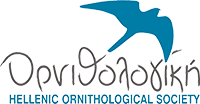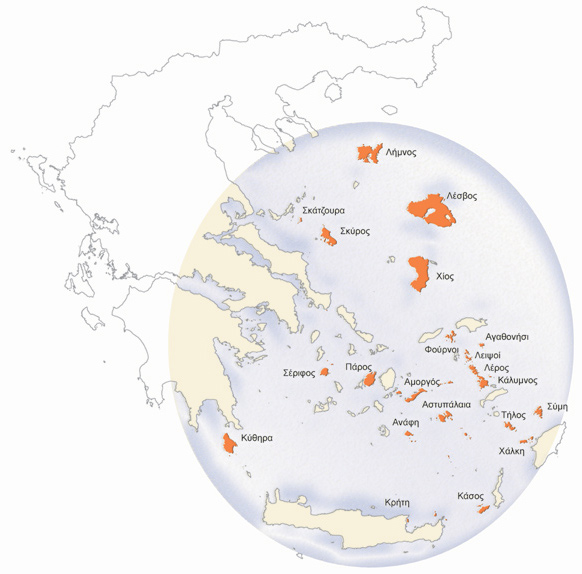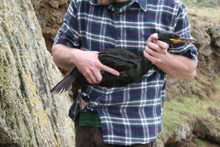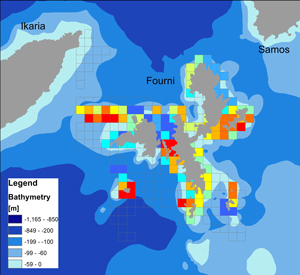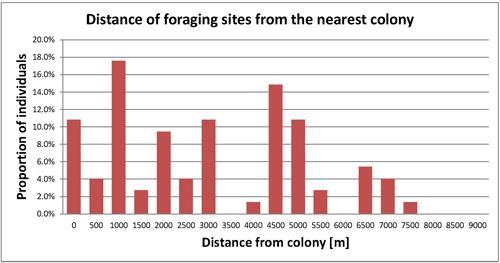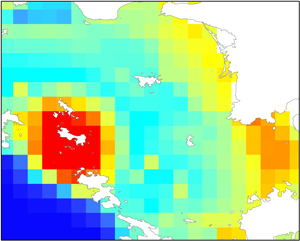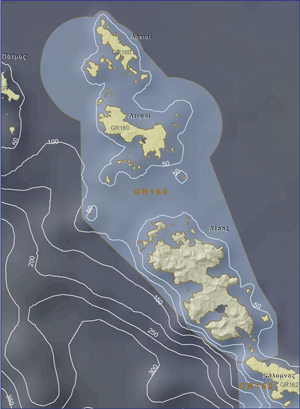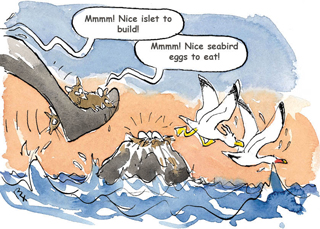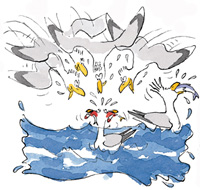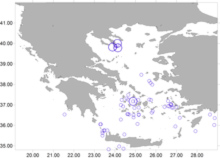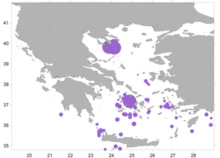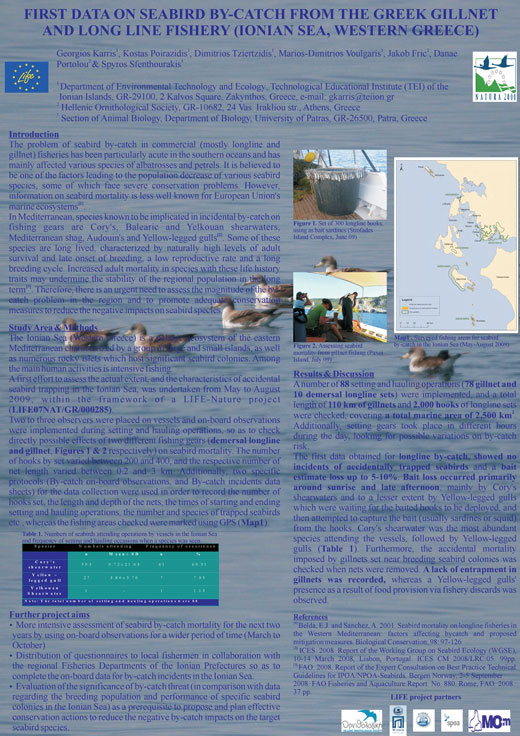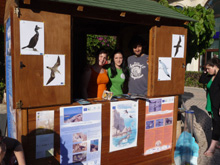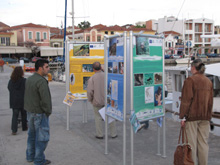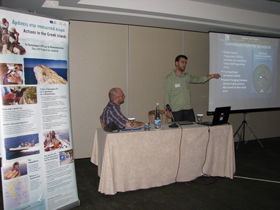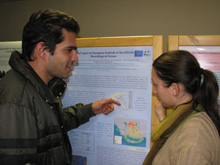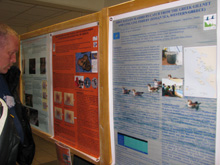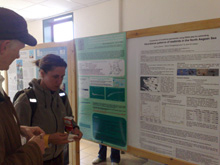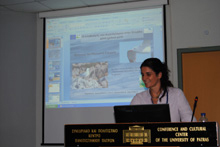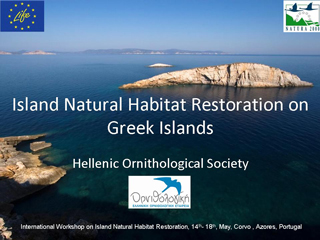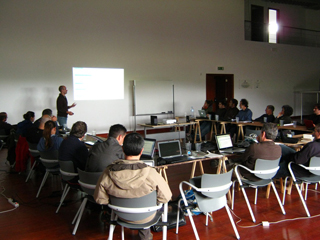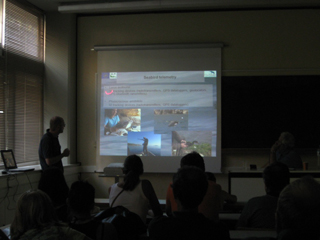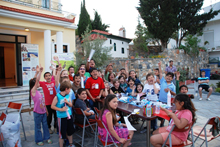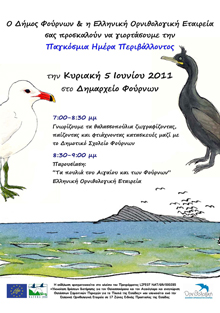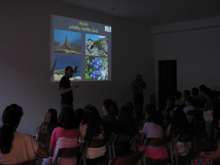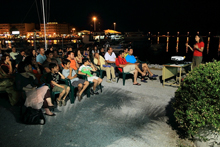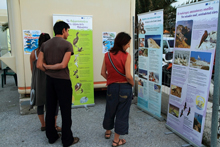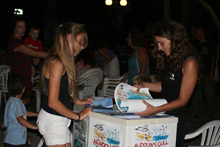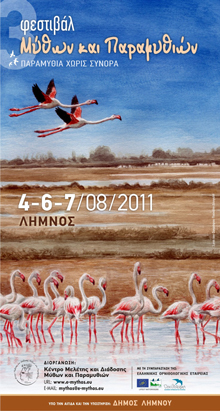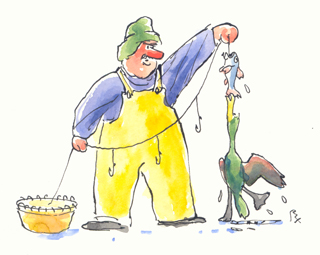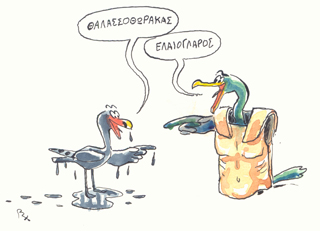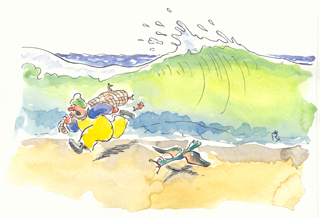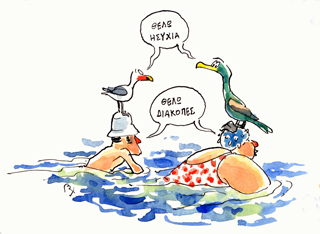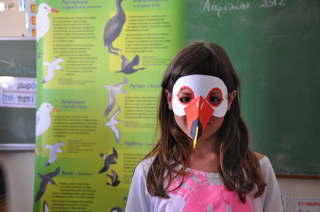- Description
- Project sites
- Actions
- Target species
- Marine IBAs Identification
- Seabird terrestrial predators control
- Seabird competitive species control
- Measures against bycatch
- Public awareness
- Publications
- Project team
The LIFE Project "Concrete conservation actions for the Mediterranean Shag and Audouin’s Gull in Greece, including the inventory of relevant marine IBAs" is implemented by the Hellenic Ornithological Society in collaboration with the Hellenic Society for the Study and Protection of the Monk Seal (ΜΟm), the Hellenic Centre for Marine Research (HCMR), the Technological Institution (TEI) of Ionian Islands and the Portuguese Society for the Study of Birds (SPEA) in 17 Greek SPA sites during 2009-2012.
The total cost of the project is estimated at €2.357.922. The financial support from the European Community is set at 75% of the total eligible cost of €1.768.442. The project is co-financed by the A.G. Leventis Foundation.
The project aims to achieve a significant improvement of the Mediterranean Shag's and Audouin's Gull conservation status in Greece, by implementing concrete conservation actions in 17 Greek SPA sites, according to the prescriptions and priorities identified by the International Action Plans for the two species
Objectives:
- Data collection for the identification of marine Important Bird Areas (marine IBAs)
- Eradication of terrestrial invasive species (rats) and population control of Yellow-legged gull on selected uninhabited islets
- Assessment and mitigation of accidental catch (by-catch) of seabirds in fishing gear
- Public Awareness and dissemination actions on major islands in Aegean and Ionian sea
- Support of coordination among European Birdlife Partners on seabird conservation and Marine IBAs
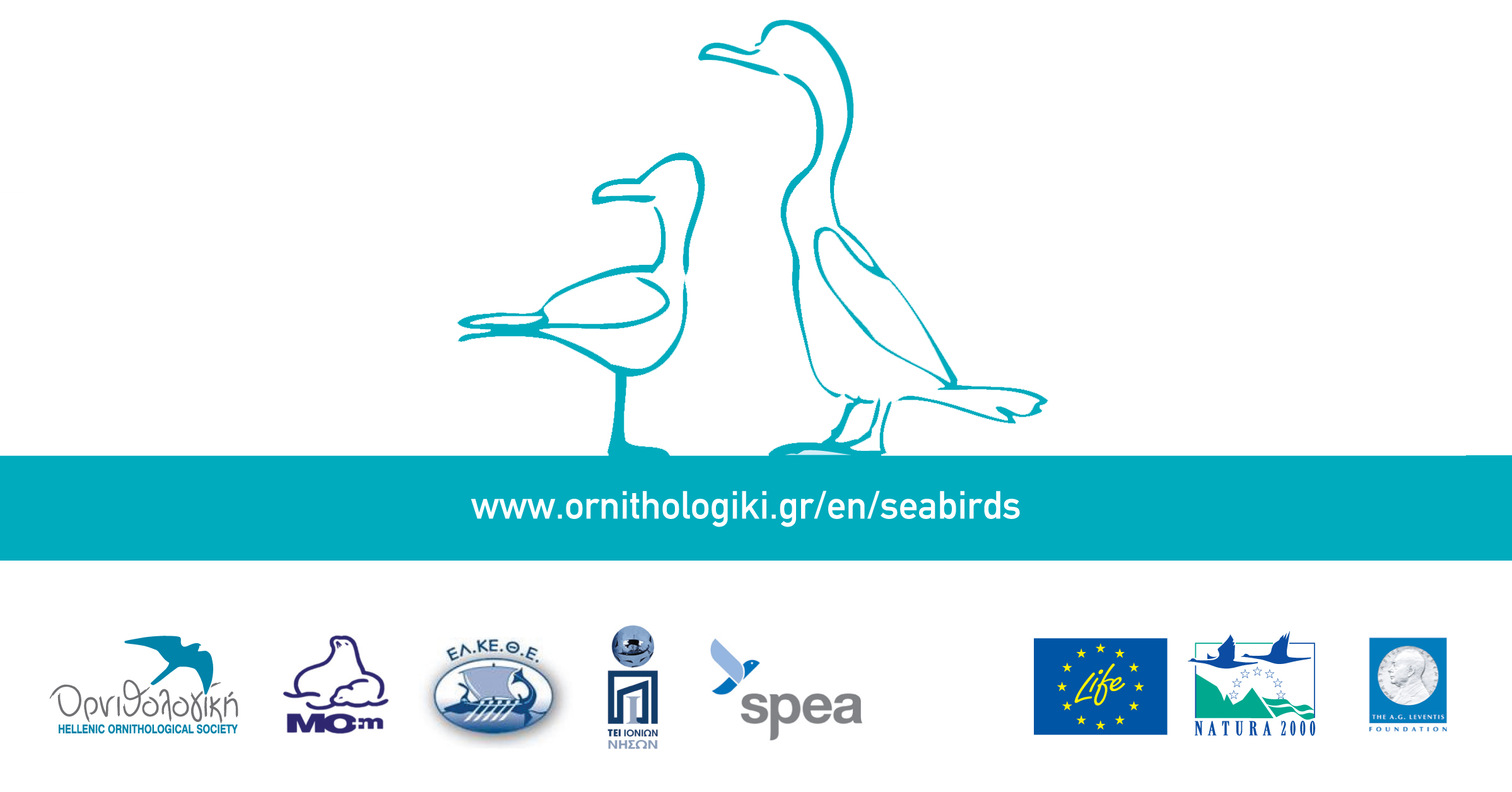
Map of the general location of the project area
The project actions are implemented at 17 Special Protection Areas (SPA) and their adjacent marine areas where the largest national populations of the Mediterranean Shag and Audouin's Gull are found.
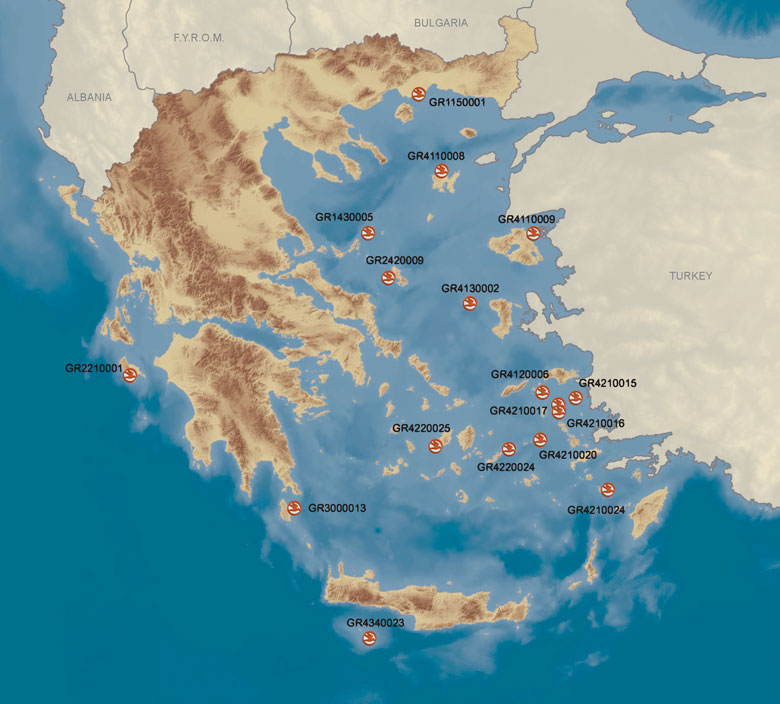
GR1150001 Nestos Delta and Thasos island GR1430005 N. Sporades island complex GR2210001 W. Zakynthos GR2420009 Skyros GR3000013 Kythira GR4110008 Limnos GR4110009 Lesvos GR4120006 Fournoi GR4130002 Antipsara GR4210015 Agathonisi GR4210016 Leipsoi GR4210017 Arkioi GR4210020 Kinaros GR4210024 Tilos GR4220024 Amorgos GR4220025 Paros and Antiparos GR4340023 Gavdos and Gavdopoula The main goal of the project is the improvement of the Mediterranean Shag (Phalacrocorax aristotelis desmarestii) and Audouin’s Gull (Larus audouinii) conservation status in Greece, by implementing concrete conservation actions in 17 Greek SPA sites, according to the prescriptions and priorities identified by the International Action Plans for the two species.

Identification of Marine Important Bird Areas (Marine IBAs)
- Seabird surveys (ESAS, coastal counts, coastal census)
- Telemetry
- Collection of oceanographic data
- Data analysis for the designation of marine IBAs
Control of populations of seabird terrestrial predators
- Assessment of islets and monitoring of breeding of the Mediterranean Shag and Audouin’s Gull
- Rat control
Control of populations of seabird competitive species
- Assessment of islets and monitoring of breeding of the Mediterranean Shag and Audouin’s Gull
- Yellow-legged Gull population control
Measures against accidental trapping of seabirds in fishing gear
- Survey and assessment of seabird accidental catch in Greece
- Identification of mitigation measures
- Campaign for fishermen on by-catch
Public awareness
- Workshops, participation at conferences, scientific publications
- Environmental education
- Special publications
- Communication and information dissemination
The Audouin's Gull & the Mediterranean Shag
The Audouin’s Gull
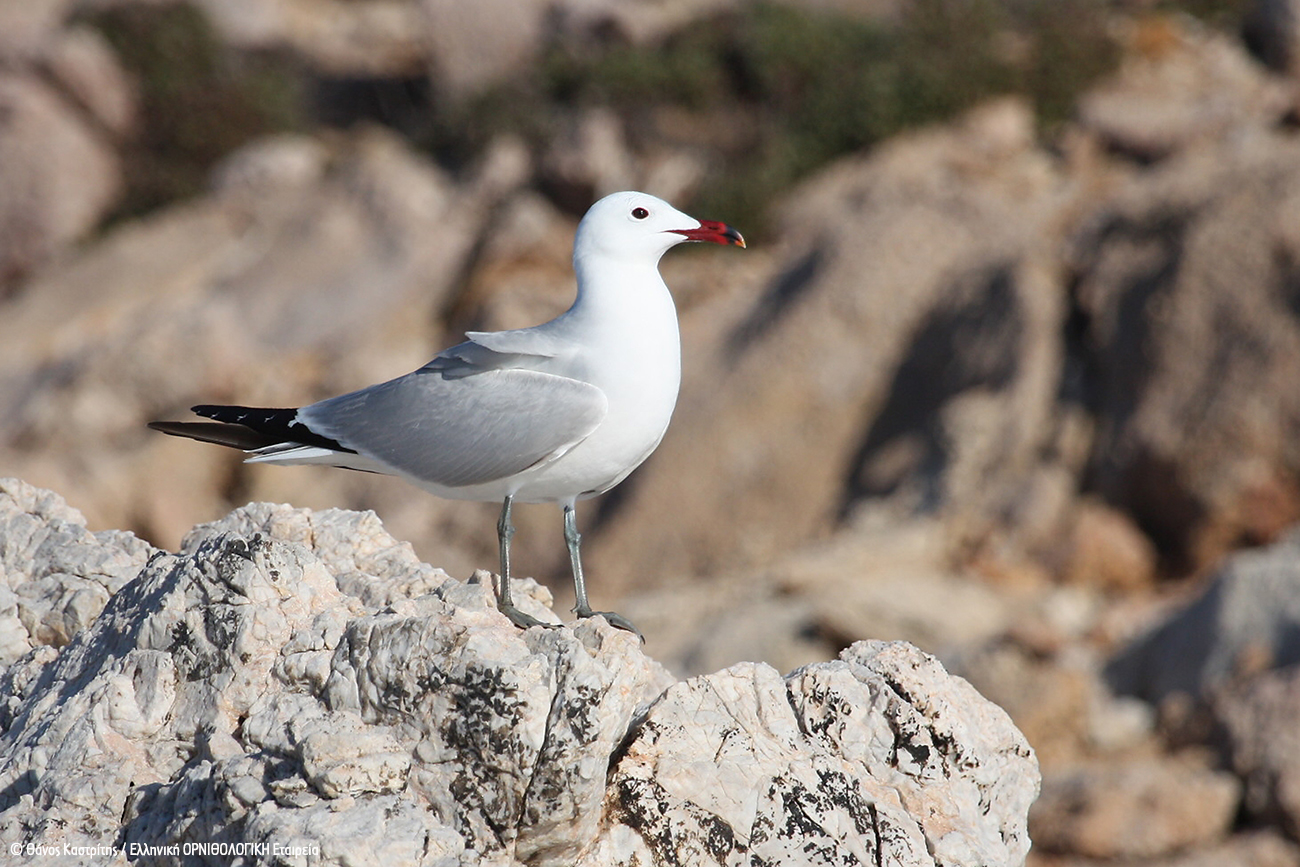
Audouin’s Gull is a gull species endemic of the Mediterranean, easily identified by its scarlet red bill and greyish-black legs. Until the 70’s, its global population was estimated only at 1.000 pairs. However, thanks to the increase of fishing, and therefore, of the amount of fish discards in western Mediterranean, global population has increased sharply. According to the latest estimations (BirdLife 2008), global population is 21.500 pairs, with 90% of it located in western Mediterranean, in Spain (the largest colony is located at the Evros Delta.The species is classified as “Nearly Threatened” by BirdLife International. It is included in Annex I of the Birds Directive 2009/147/EC, in Annex II of the Bern Convention, and in Annex I of the Bonn Convention. In addition, it is classified as “Vulnerable” in the new Red Data Book of Endangered Animals of Greece (Handrinos & Kastritis, 2009).

Audouin’s gulls are present in Greece only during the breeding season, so our knowledge of the species is mainly reduced to this period of time. The Greek population is estimated around 350-500 pairs and breeds only in the Aegean, in colonies of 5 to 85 pairs. The colonies are located on isolated rocky islets with little vegetation, mainly in the Dodecanese, Fournoi, Amorgos, Paros, Sporades island complex, Lesvos, Lemnos, Chios and Crete.In Greece, the species typically changes colony site from year to year, that is to say, the birds don’t return every year to the same site, but rather move to other nearby islets.
By the end of April, adults are already settled in the colonies, laying two to three eggs in grass-made nests located on the ground. Incubation lasts for three weeks and chicks start to hatch by mid May. A month later, fledglings are ready to fly, but will need four more years before they reach adulthood, when they will moult into the white adult plumage and start to breed. From mid July and onwards, both adults and juveniles start abandoning the colony and dispersing in the surrounding areas. From then on, wintering areas and migration routes of Greek populations remain unknown, although there have been resightings of ringed individuals in Cyprus, Crete, Malta, Lebanon, Tunisia and Spain!
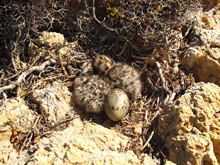
Audouin’s Gull feeds close the coast, mainly on small fish close to the sea surface which they skilfully catch by flying slowly just above the water. In western Mediterranean, the species feeds mainly on discards from fishing boats.
Audouin’s Gull in numbers
Length: 0,5 m
Wing span: 1,3 m
Distribution: Nests exclusively on Mediterranean islands
Greek population: 350 - 500 pairsThreats
The species most significant threat is human disturbance during breeding season, which has direct impact on colony size and leads to small and isolated colonies. Human disturbance with negative impact on the colonies varies from stock breeding, over-grazing, fishing, hunting to tourism and construction of infrastructures. Other threats of course, are the decrease of fish stock, mortality by accidental trapping in fishing gear (by-catch), sea pollution, as well as egg and chick predation from rats, Yellow-legged gulls, or Hooded crows. Competition with Yellow-legged gulls for nesting sites and food also has a negative impact on the species.
How does the LIFE project help the species?
Different actions are being implemented within the framework of the LIFE project, aiming to increase our knowledge of the species ecology at sea and its threats, and to designate Marine IBAs. At the same time, in order to increase the species conservation status, different management actions will be tested, in particular those related to terrestrial and Yellow-legged Gull predation, and by-catch.
The following actions are being implemented in order to obtain the necessary information to fulfil the project’s objectives:
a) Population census in project regions, in order to locate breeding colonies and update the breeding population estimates.
b) Monitoring of selected breeding colonies in order to estimate breeding success.
c) Monitoring of adult individuals through GPS telemetry (implemented for the first time in Greece) in order to identify the species main foraging areas
d) Chick ringing in order to obtain information on the species migration routes
e) Preliminary estimation of the negative impact of Yellow-legged Gull predation and competition.The Mediterranean Shag
Greece hosts all three members of the Cormorant family: the Mediterranean Shag (Phalacrocorax aristotelis), the Great Cormorant (Phalacrocorax carbo) and the Pygmy Cormorant (Phalacrocorax pygmeus). It is noteworthy that the Mediterranean shags present in Greece are in fact a subspecies endemic of the Mediterranean (Phalacrocorax aristotelis desmarestii). The subspecies population is estimated to be fewer than 10.000 pairs, with 1.000-2.000 in the Greek islands of the Aegean and Ionian Sea. Although the knowledge about the species distribution and ecology in Greece has greatly improved during the last decade, there are still gaps, especially regarding the species distribution and behaviour at sea.
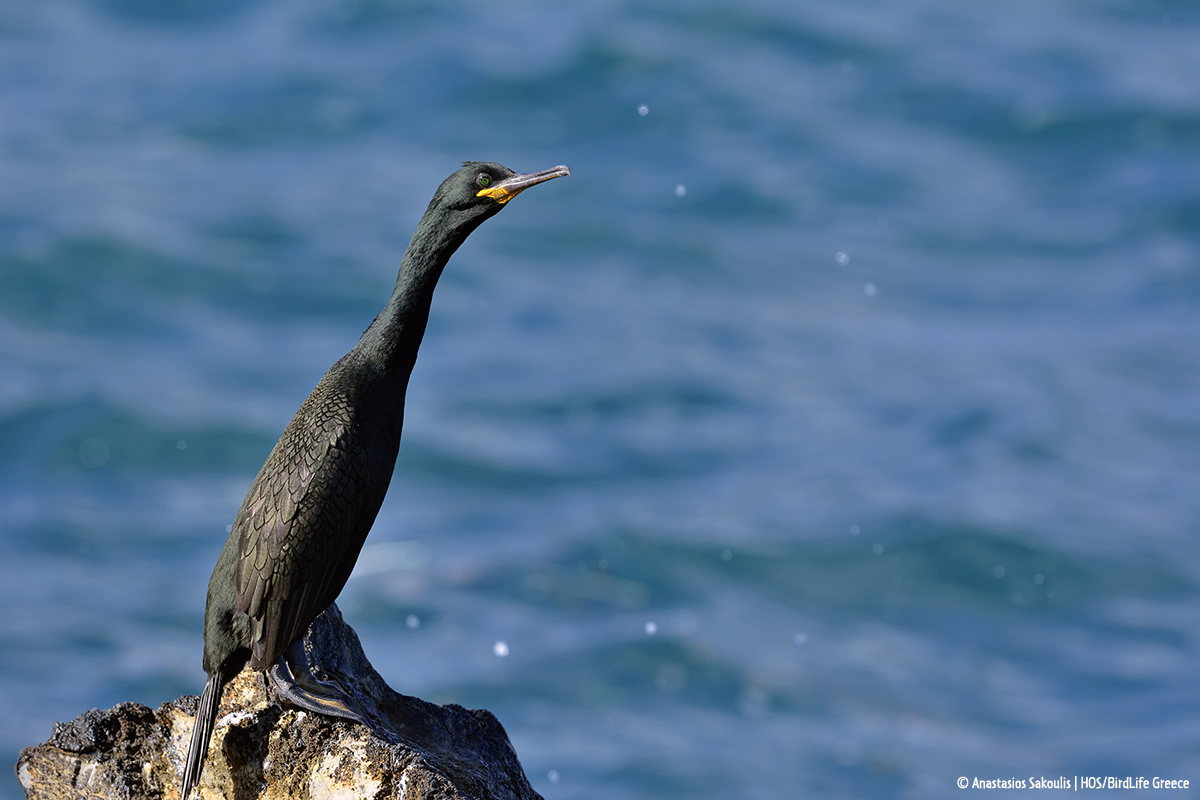

For the last six years, the Hellenic Ornithological Society (HOS) consistently surveys all of the species breeding and wintering sites in Greece; so far, 424 breeding sites have been recorded. In addition, HOS also carries out systematic monitoring and ringing of chicks and adult individuals at selected breeding colonies in North Sporades and North Aegean giving the first data on the species ecology and movements in Greece. Thus, in the last three years HOS fieldwork teams have covered around 3.200 km2 of sea areas while searching for the species feeding areas.
The Mediterranean Shag is protected both national and internationally: it is included in Annex I of the Birds Directive 2009/147/EC as well as in Annex II of the Bonn Convention; in addition, there is also an International Action Plan for the Mediterranean subspecies. The species is also classified as “Nearly Threatened” in the Red Data Book of Endangered Animals of Greece.
The Mediterranean Shag is a species typical of coastal areas, and unlike its close relatives the Great Cormorants and the Pygmy Cormorants, it can be found exclusively at sea. It is very frequently observed roosting or drying its plumage on rocks along the coastline, or fishing in the sea close to the coast. It feeds mainly on fish, diving up to 60 m to catch them. Its breeding range covers all of the Greek seas, from Gavdos in the Libyan Sea, to Thasos in the North Aegean, and from Zakynthos in the Ionian Sea to the Dodecanese. It usually nests in sheltered hollows in rocky coastlines or under thick shrubs; the nest is typically made from plant material, but it can also contain different types of rubbish, which the shags use in a questionable attempt to increase the quality of their nest! Breeding is not synchronised, neither among colonies nor among the nests of the same colony, and can therefore last from December to June of the following year. In Greece, the average clutch size is 2-3 eggs, which hatch a month later. Fledglings leave the nest 6-7 weeks after hatching, but will stay close to the colony forming large groups.
Once the breeding period ends, Shags will either stay alone, or group together, in groups of anything from a few individuals to hundreds of them, and might decide to leave the colony in search of better foraging grounds. The species is present in Greece all year round, and according to data from ringed individuals, can move locally up to 200 km away from their colony.The Mediterranean Shag in numbers
Length: 0,75 m
Wing span: 1 m
Distribution: Islands and rocky coasts of the Mediterranean and the Black Sea
Greek population: 1000 - 2000 pairs
ThreatsThe species main threats are human disturbance, degradation and loss of habitat both on land and at sea, mammal (rats) or bird (e.g. Yellow-legged Gull) predation, mortality by accidental trapping in fishing gear (by-catch), overfishing and oil spills.
How does the LIFE project help the species?
The LIFE project aims to improve the knowledge of the species distribution and ecology both on land and at sea, giving special attention to the designation of Marine IBAs in Greece. In order to achieve these goals, HOS implements classical methodologies of census and monitoring, in combination with other modern technologies such as spatial modelling and radio and GPS telemetry, the latter being particularly effective for the study of the species at sea. At the same time, HOS will carry out management actions against the species main threats, such as rat and Yellow-legged Gull predation, and by-catch.
HOS collaborates with the University of Patras in the elaboration of several PhD theses focused on the species breeding ecology and the phylogeographic differentiation of Greek populations.
By the end of the LIFE project in 2012, a significant improvement is expected in the knowledge of species distribution on land and at seas as well as its conservation status in Greece through the implementation of project concrete conservation actions.A BirdLife International project on Important Bird Areas (IBAs) that started in early 1980s’, has created an extensive network of IBAs, which consisting of more than 10.000 areas, primarily terrestrial, throughout the world. In Greece, HOS has identified 196 IBAs of which only a small percentage includes a marine component.

The need for identification of IBAs in the marine environment (marine IBAs) was obvious from the beginning, however the systematic surveys of the distribution and activities of birds at sea for the delineation of marine IBAs are being carried out only during the last decade. The main reason for this delays were lack of appropriate standardized methods of recording seabirds at sea, lack of technology for monitoring seabird movements as well as large costs of surveys at sea.
The need for the identification of marine IBAs was further increased towards the end of the 20th century seabirds when it became evident that seabirds are the most threatened group of birds, worldwide. In Europe this situation lead to an intensive development of new methods for the survey and monitoring of seabirds and increased funding opportunities for national marine IBA projects.
Marine IBA identification process in Greece started in 2007, with the project “Survey and Conservation of Seabirds in Greece”, funded by the A.G. Leventis Foundation and was further expanded with the present LIFE-Nature project in 2009.
One of the main objectives of the LIFE project is the identification of Marine IBAs for the Mediterranean Shag (Phalacrocorax aristotelis desmarestii) and the Audouin’s Gull (Larus audouinii), two priority species, listed in Annex I of the Birds Directive, that breed in significant numbers in Greece.
There are four types of marine IBAs:
1. Seaward extensions of the seabirds colonies in the existing terrestrial IBAs
2. Coastal and inshore marine areas hosting concentrations of seabirds
3. Pelagic areas hosting concentrations of seabirds
4. Migrations hotspots
For the purpose of marine IBA designation in Greece, systematic surveys are being carried out to collect data regarding the seabird distribution at sea and along the coast as well as the distribution of seabird colonies. The methods applied include census of seabird colonies on islands and islets, recording of seabirds at sea with research boats and ferry boats, telemetry using radio- and GPS tracking as well as bird ringing. These data are statistically analyzed in association with the oceanographic, fisheries and biological data to delineate marine IBAs.
The greatest achievement of the project “Survey and conservation of seabirds in Greece” was a pilot application and acquisition of experience in implementation of all methods required for designation of marine IBAs. Therefore the present LIFE project provided the opportunity to apply these methods to a full extent in 17 project SPA sites with special emphasis on the Mediterranean Shag and Audouin’s Gull. The actions related to marine IBA identification will continue until 2012 when a full inventory of marine IBAs in the project areas will be produced.
Following below are detailed descriptions of the project actions related to marine IBA designation:Seabird surveys
Recording seabirds at sea (ESAS)
One of the main project actions related to the designation of marine IBAs is recording seabirds at sea with the method European Seabirds at Sea (ESAS). This method was first applied in the beginning of 1980s’ inNW Europe, and since 2007 it is also being applied in Greece.
The method is based on continuous recording of seabirds at sea along the ship route (line-transect), carried out from a ferry boat or a research boat travelling at a speed up to 20 knots.
The main goal of ESAS is to determine the distribution and activities of seabirds at sea.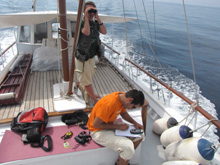
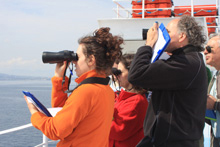
The most common seabird species being recorded by ESAS in Greece, apart from the Mediterranean Shag and Audouin’s Gull are Cory’s Shearwater (Calonectris diomedea), Yelkouan Shearwater (Puffinus yelkouan), European Storm-petrel (Hydrobates pelagicus) and Yellow-legged Gull (Larus michahellis). Apart from seabird presence, number of individuals and behaviour, ESAS also records other species of marine fauna (e.g. cetaceans, fish), human activities (e.g. fishing) and floating matter in order to explain why the seabirds use particular marine areas and to improve our understanding of their behavior and ecology.
The observation team usually consists of two experienced observers. While the first observer is observing seabirds at sea, the other is recording the data in specifically designed datasheets, one to bird records and one for the ship route.
The original ESAS datasheets were adapted to Greek conditions and the requirements of the project and translated in Greek.
A detailed description of the ESAS methodology is provided here
Within the present project ESAS surveys are being carried by MOm in the Northern Aegean Sea and by HOS in the rest of Greek marine areas.
From the beginning of the LIFE project in 2009 until autumn 2012, more than 260 survey trips of total distance more than 18.100km have been completed, covering all major regions of the Aegean and Ionian sea. During these trips in total more than 67.000 individuals of seabirds and other marine species have been recorded.
Volunteers play an important role in ESAS surveys. Training seminars for ESAS volunteers have been organized in 2009.
For further information regarding participation in volunteer ESAS surveys, please contact ESAS coordinator Jakob Fric.
It should be noted that the volunteer ESAS surveys are supported by MINOAN Lines, ANEK Lines, Blue Star Ferries και Superfast Ferries shipping companies that kindly provided ferry boat tickets.




Coastal counts and coastal census
In parallel to the ESAS surveys, that take place primarily at open sea, coastal counts and coastal census record seabirds in coastal waters. These surveys are carried out on land and from a boat, respectively.
During coastal census, the observers record all the birds on the coast or coastal waters while the boat slowly follows the coastline. This method is a kind of line-transect method. The bird records are associated with census sectors in which the entire coastline of the survey areas has been divided. Similar methods has already been successfully applied in the first global census of the Eleonora’s Falcon (Falco eleonorae). The method is particularly suitable for recording seabird species that use coastal water for feeding and resting, which is the case of the Audouin’s Gull and the Mediterranean Shag. Until autumn 2012 coastal census surveys have covered more than 3000 km of coastline in the project sites.
Coastal counts on the other hand are carried out from selected observation points on the coast adjacent marine areas with concentrations of seabirds. This method is a kind of point-count methods. The observers with the use of a telescope and binoculars record the number and behavior of seabirds in order to determine the use of the marine areas by seabirds. Up till now 260 man-hour of coastal counts have been realized from selected locations on islands in the northern and central Aegean Sea and in the Northern Dodecanese.Results:
Marine areas covered by seabird surveys (until autumn 2012)
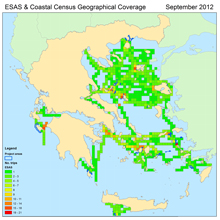
Total number of recorded number of seabird individuals (until October 2010)Coastal census Coastal counts ESAS Total Survey effort 2,972 km 12 sites/260h 18,192km 21,164 km Larus audouinii 1,303 110 203 1,616 Phalacrocorax aristotelis 6,546 719 2,386 9,651 Calonectris diomedea 336 19,954 13,015 33,305 Puffinus yelkouan 183 71,004 19,953 90,140 Hydrobates pelagicus 17 17 Larus michahellis 32,533 1,236 29,126 62,895 * Caution! The above totals represent sums of all recorded individuals and do not correspond to seabird populations in project areas, because in several areas surveys were repeated in between 2009 and in 2012.
Distribution of recorded seabirds per species:
Mediterranean Shag: Audouin’s Gull: Cory’s Shearwater: 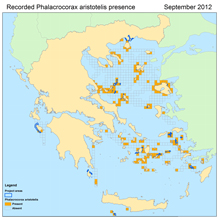
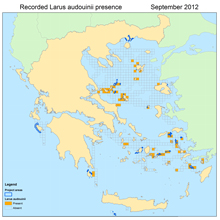
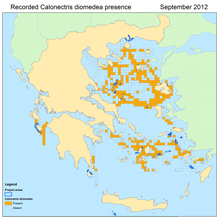
Yelkouan Shearwater: Yellow-legged gull: 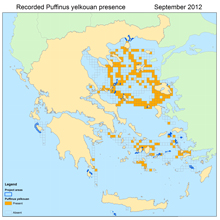
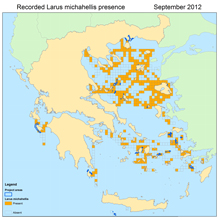
Other species of seabirds and waterbirds recorded: Common sandpiper(Actitis hypoleucos), Common Kingfisher (Alcedo atthis), Mallard (Anas platyrhynchos), Garganey (Anas querquedula), Great Egret (Casmerodius albus), Grey Heron (Adrea cinerea), Πορφυροτσικνιάς (Ardea purpurea), Squacco Heron (Ardeola ralloides), Purple Heron(Charadrius dubius), Whiskered Tern (Chlidonias hybrida), Black Tern (Chlidonias niger), Little Egret (Egretta garzetta), Black-throated Diver (Gavia arctica), Red-throated Diver (Gavia stellata), Slender-billed Gull (Larus genei), Mediterranean Gull (Larus melanocephalus), Little Gull (Larus minutus), Black-headed Gull (Larus ridibundus), Cormorant (Phalacrocorax carbo), Great Crested Grege (Podiceps cristatus Little Tern (Sterna albifrons), Bridled Tern (Sterna anaethetus), Caspian Tern (Sterna caspia), Common Tern (Sterna hirundo), Arctic Skua (Stercorarius parasiticus) and Sandwich Tern (Sterna sandvicensis)
Οther marine species recorded:
Monk Seal (Monachus monachus), Common Dolphin (Delphinus delphis), Risso’s Dolphin (Grampus griseus), Ocean Sunfish (Mola mola), Sperm Whale (Physeter macrocephalus), Striped Dolphin (Stenella coeruleoalba), Bottlenose Dolphin (Tursiops truncatus), Swordfish (Xiphias gladius), Cuvier's Beaked Whale (Ziphius cavirostris) and Loggerhead Sea Turtle (Caretta caretta).Deliverables:
- ESAS datasheets( route datasheet, records datasheet, or both for EXCEL)
- ESAS guidelines (pdf)
Telemetry
Telemetry has become of the main methods for the study of bird ecology in their natural environment and complementary to bird ringing tries to answer a basic question: What birds do beyond the visual field of view of an observer?
For this purpose and particularly during recent year, several types of telemetry methods have been developed and improved. These methods usually belong to one of three main categories: radiotracking, tracking using satellite systems like GPS or Argos, recording various environmental variables using dataloggers. Each of these methods has its advantages and is suitable answer particular scientific questions. Radiotracking is the most common technique because it is cheap and allows tracking of large number of individuals. However it requires great efforts and it has limited range. On the other hand, satellite telemetry systems have a remarkable spatial accuracy and range but their price is equivalently high. And above all the main limiting factor is the weight of tracking devices which birds carry but should not obstruct them. Therefore the selection of the most suitable method is always a quest for the best compromise between capabilities and restrictions of each method.
In the framework of the LIFE project telemetry is being used for the study of daily and seasonal movements of selected individuals of Audouin’s Gull and Mediterranean Shag in order to determine the most important foraging and resting marine areas and migratory corridors used by bird breeding in the project areas. For this purpose 3 types of telemetry methods are being used:
1. RadiotrackingSelected individuals of target species are equipped with light-weight radio transmitters, which are then tracked with mobile antennas. The location of each individual with the tag is determined by triangulation.

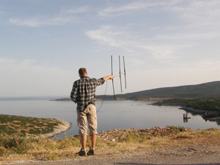
2. GPS dataloggers
Dataloggers with a build-in GPS receiver are mounted on birds to record their positions with great spatial and temporal accuracy.3. Geolocators
Geolocators are dataloggers which record the intensity of sunlight. The location of the birds is determined from the time of sunrise and sunset as well as the duration of the day.
Apart from using above telemetry methods for monitoring bird movements and behavior at sea, bird movements and migration are being surveyed by bird ringing. A set of one metal and one plastic ring is mounted on juvenile and adults Mediterranean Shags and Audouin’s Gulls to allow for their future recovery and recognition.Results:
Up until summer 2012, 32 Audouin’s Gulls from N. Aegean Sea and N. Dodecanese have been equipped radiotransmitters, GPS dataloggers and geolocators and 32 Shags from the N. Aegean Sea with radiotransmitters.
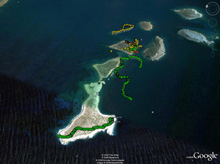
Map of recovered ringed Audouin's Gulls in the Mediterranean region 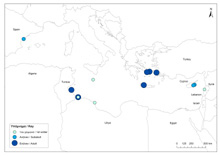

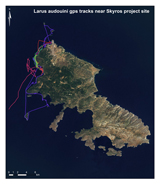
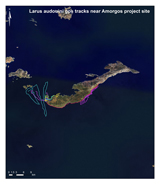
Collection of oceanographic data
The distribution of seabirds at sea and particularly their foraging areas depend on various oceanographic meteorological and biological parameters. In order to improve delineation of the marine IBAs the Hellenic Centre for Marine Research (HCMR) is collecting a series of oceanographic, fisheries meteorological data which effect the use of marine areas by seabirds. The types of data include:
- Bathymetry
- Sea surface temperature (SST)
- Sea surface salinity (SSS)
- Chlorophyll(Chl-a)
- Wind direction and strength
- Distribution of main seas prey species
These data are then correlated with the records of seabirds at sea in order to delineate marine IBAs.
Examples of oceanographic data:Sea surface temperature (SST) Sea surface salinity (SSS) Wind direction and strength 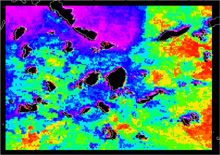


Data analysis for the designation of marine IBAs
The final stage of designation of marine IBAs consists of the management and analysis of aforementioned datasets, namely:
- Locations of seabird colonies,
- ESAS records,
- Coastal counts (from land) and coastal census (from sea) records,
- Telemetry data,
- Bird ring recoveries,
- Oceanographic, biological and fisheries data. Based on these datasets four types of marine IBAs are designated
- Seaward extensions of the seabirds colonies in the existing terrestrial IBAs
- Coastal and inshore marine areas hosting concentrations of seabirds
- Pelagic areas hosting concentrations of seabirds
- Migrations hotspots
In order to manage and analyze data, relevant database are developed and used. They are compatible with GIS (Geographic Information System) environment and statistical models to allow for spatial and temporal data analysis. In the end marine IBAs are designated on the basis of the Birdlife International criteria for marine IBAs. The inventory of marine IBAs for the Mediterranean Shag and the Audouin’s Gull in the project sites will be compiled by the end of the LIFE project in 2012.
Results:
Within the framework of the project a series of databases have been adapted and developed to manage data on:- Seabird colonies
- ESAS
- Coastal counts and coastal census
- Telemetry and Oceanographic and biological dataAll the data that have been collected until summer 2012 are being managed in the aforementioned databases and analyzed by statistical analysis and modelling to determine marine distribution of seabirds. In total 39 potential marine IBA sites have already been identified and delineated based on the distribution and size of seabird colonies, recorded marine distribution of seabirds, telemetry data and habitat modelling and application of BirdLife International IBA criteria.
Examples:
Recorded distribution of the Mediterranean Shag in the marine area around Fournoi (N. Aegean)
Water depth at Mediterranean Shag’s foraging sites indicating foraging in shallow coastal water.
Distance of Mediterranean Shag’s foraging sites from the nearest colonies indicating foraging at distances up to 7.5km.
MaxEnt model in telemetry data acquired from Audouin’s Gull s breeding on Leipsi. Apart from foraging in radius of up to 10km around the colony, Audouin’s Gulls also feed in coastal waters of Turkey.
A proposed marine IBA in the Northern Dodecanese.
The islands and islets of the Aegean and Ionian Sea give shelter to the majority of Greek seabird populations, providing them with ideal nesting, resting and wintering sites.Due to human activities, the areas available to seabirds on larger and inhabited islands have been reduced to a minimum. Therefore, the only terrestrial habitats suitable for seabirds left are uninhabited islands and islets. However, even these are not free from direct or indirect human impacts having, in many occasions, negative effects on seabird populations.
Among the main objectives of the LIFE project is the mitigation of rat (Rattus sp.) predation, one of the most important threats to Mediterranean Shag and Audouin’s Gull. Rat predation on seabird eggs, nestlings or even adult birds is a phenomenon common throughout the world, which leads to reduced breeding success or even worse, to abandonment of colonies. Rats are an alien invasive species in Greece, and can have negative effects not only on seabirds, but also on the rest of native fauna and flora including small mammals, birds, reptiles, invertebrates and endemic plants. Therefore, removal of rats from uninhabited islets is one of the necessary prerequisites for the restoration of ecological equilibrium in island ecosystems, bringing also long-term benefits to native animal and plant species.
For the reasons described above, the present LIFE project aims to the removal of rats from at least five island or islet complexes within the project areas hosting important Mediterranean Shag or the Audouin’s Gull colonies, covering a total land surface area of at least 400-500 ha. These rat removals are expected to significantly improve the breeding performance of the Mediterranean Shag and the Audouin’s Gull on the national level.
Removal of rats is time-consuming and costly, both in financial resources and human effort. Therefore potential rat removal sites must be prioritized prior to rat removal operations in order to ensure optimal ecological benefits for a given cost. The prioritization is based on information such as presence or absence of rats, the level of rat predation on seabird colonies, presence of other mammals and in general other fauna, type of vegetation and vegetation coverage of the islands, human presence and activities, accessibility of the islands both to people and rats, geographical and topographical characteristics of the islands, etc. Taking into account all these parameters and the estimated cost of rat removal operations, every islet and complex of islets is evaluated using cost-benefit analysis to determine those where the ecological benefits are the greatest, given the cost.Subsequently, for each high priority islet or islet complex, the removal method is designed and implemented to ensure an effective removal of rats and safety of other species, including seabirds. The removal of rats is followed by a systematic monitoring of the target islets to study the progress of the rat removal, its effect on the entire ecosystem and particularly on the seabirds breeding success. This monitoring must last at least one year before an islet can be declared rat-free.
On the other hand, prevention of rat invasion or rat reinvasion on rat-free islands is as important as their removal. For this reason, contingency measures are taken for all islands where rats have been removed, accompanied by an information campaign for the general public as well as specific social groups (e.g. fishermen, shepherds, tourists and others).
It should be noted that the removal of rats within the framework of the present project comes as the continuation of successful pilot rat removal operations of the LIFE-Nature project“Conservation of Falco eleonorae in Greece”, which proved the multiple benefits that rat removal provides to birds, other native fauna and the vegetation of the islets.Results:
The first step in the prioritization of the islands for potential rat removal operations was the design of the prioritization method. The method is based on the Brooke-Hilton cost-benefit analysis and was further adapted to the Greek conditions and the needs of the LIFE project. Based on this method, required information was collected for the islands and islets in the project sites. Finally, prioritization analysis was carried out for 83 islet and island complexes hosting colonies of the Mediterranean Shag and/or Audouin’s Gull. The first 20 islet complexes with the highest priority of rat removal belong to the following regions:
Region No. of complexes 1. Thasos 2 2. Skyros 3 3. Kythera 2 4. Limnos 1 5. Amorgos 2 6. Leipsi 2 7. N. Sporades 2 8. Fourni 3 9. Agathonisi 2 10. Lesvos 1 The implementation of rat removal operations started on islets in Skyros in September 2010. Until autumn 2012, rat removal has been carried out on 19 uninhabited islets within 8 islet complexes where post-eradication monitoring is still in progress.
Region No. of complexes Total area (ha) % of P. aristotelis National population % of L . audouini National population Skyros 2 11 2.6-3.2% 2.6-4.3% Thasos 1 21 5.4-7.4% - Kythera 1 3 - 2.4-12.0% Fournoi 2 98 3.0-4.1% 3.2-24.6% Amorgos 2 89 - 3.0-11.1% Paros 1 29 1.3-2.0% - Total 5 133 12.5-16.7% 11.2-52% Throughout the entire duration of rat removal and during post-removal monitoring, the presence of rats is monitored with the use of bait stations, where bait consumption is checked on a daily basis. The example below demonstrates the progress of rat removal:
Progress of rat removal on selected islet of Skyros 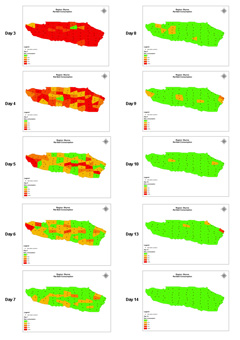

- The Yellow-legged Gull (Larus michahellis), is the most common and frequently observed gull in Greece. It is an opportunistic species with a breeding range stretching out all over the Mediterranean. During the last decades, the species populations have increased significantly, mainly due to the increase of food sources related to human activities (e.g. rubbish dumps, fishing discards). The unnaturally large Yellow-legged Gull population has a negative impact on other seabird species, triggering problems such as competition for food and nesting sites, or predation of nests. Audouin’s Gull(Larus audouinii), is especially vulnerable as both gull species share nesting and feeding sites.
In addition, rubbish dumps will be shutting down in the following years, meaning an important decrease in food sources for the Yellow-legged Gull populations. Although, in the long term, this will probably lead to a decrease in the population numbers, in the short term, it will probably lead to an increase in the pressure on other seabirds this species competes with or predates on. The impact of this process on other seabird species can be avoided, or at least decreased, through the implementation of suitable management measures.
The objective of this action is to test different methods of population control for the Yellow-legged Gull at selected project sites, aiming to improve breeding success of other seabird species, such as Audouin’s Gull and Mediterranean Shag. These methods should reduce the species breeding success, which in combination with the shutting down of rubbish dumps will consequently induce a decrease the species population in the area; the latter will have a positive effect on the breeding conditions of other seabirds.
Before any management measure can be implemented, a full assessment of all suitable methodologies and appropriate locations must be carried out, and the population control of the Yellow-legged Gull is no exception. Therefore, existing methodologies already implemented in other regions of the Mediterranean are tested in order to select and execute the most suitable ones. At the same time, HOS carries out an assessment of Yellow-legged Gull colonies in all project sites in order to select those where the population control will be implemented.
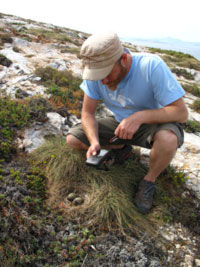
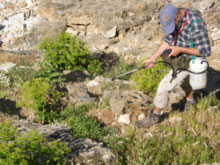
The assessment of an islet addresses both the number of Yellow-legged gulls and their impact on other seabirds, and the suitableness of the islet for the implementation of the control method. After this, the selected methods will be implemented and their effectiveness monitored, giving special attention to their impact on the Yellow-legged Gull but also on Audouin’s Gull and Mediterranean Shag.
This action will provide the knowledge, know-how and experience on the implementation of population control methods needed to successfully apply this management action in the near future in other areas for the conservation of other seabird species and biodiversity of Greek islands and islets.
Results:
The assessment of the existing population control methods for the Yellow-legged Gull has evaluated different methods included within the following categories: 1) methods involving the management of Yellow-legged Gull nesting sites, 2) methods involving the control of adult Yellow-legged Gull numbers, and 3) methods involving the control of Yellow-legged Gull breeding success.
This assessment showed that the best methods are those controlling breeding success, such as removal or oiling of eggs.On the other hand, the assessment of islands and islets involved 144 uninhabited islets with Yellow-legged Gull colonies within the project sites. 13 different parameters were taken into account, including size and location of Yellow-legged Gull, Audouin’s Gull and Mediterranean Shag colonies, total population of each species in each region, distances among colonies, level of predation/competition of the Yellow-legged Gull with other species, presence and management of Yellow-legged Gull food sources (e.g. rubbish dumps, fishing) in the area, etc. Finally, a cost-benefit analysis was applied to determine where the ecological benefits are the greatest, giving as a result a list of high priority colonies where the Yellow-legged Gull population control method should be implemented.
The following table shows the 20 top priority colonies:Region No. of colonies in each region Thasos 2 Skyros 6 Limnos 3 Agathonisi 1 Amorgos 1 Arkoi 1 Zakynthos 1 Kinaros 1 North Sporades 1 Kythira 2 Gaudos 1 The first pilot actions for the population control of Yellow-legged Gull were already implemented in spring 2010 on an islet in Thasos, and three islets in Skyros. In total, the action involved 256 Yellow-legged Gull nests, out of which only four eggs hatched. This means the action had a 99% of success. In 2012 a pilot action of Yellow-legged Gull’s breeding performance control continued on islets of Kythera and Thasos which also host colonies of the Audouin’s Gull and Mediterranean Shag. In total 479 nests were treated preventing hatching of 1064 Yellow-legged Gull’s eggs.
For hundreds of years fishermen and seabirds have been sharing the sea, as collaborators, rather than competitors. However, the introduction of modern fishing gear and practices, and their increasing use has disturbed this balance at the expense of seabirds. Seabird mortality by accidental trapping in fishing gear (seabird bycatch) is a worldwide phenomenon which has been identified to be among the major threats to seabirds together with overfishing and degradation of marine habitats.
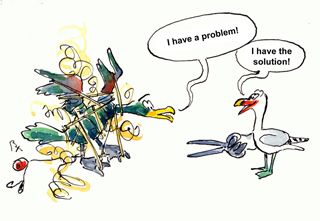
The Aegean and Ionian Sea, as the rest of the Mediterranean Sea, are no exception in this matter. In Greece, all seabird species including those of conservation concern, such as the Mediterranean Shag and the Audouin’s Gull, are victims of seabird bycatch. Although the problem is well known in Greece, up until present LIFE project, no systematic assessment of bycatch has been carried out, meaning that the extent of accidental trapping of seabirds in the fishing gear, and therefore its impact on the national populations of seabirds species have not been yet determined.
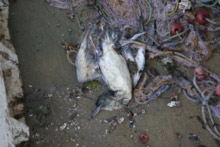
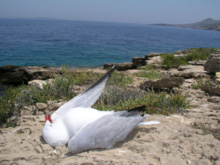
Therefore, the present LIFE project is aiming to assess the extent of seabird bycatch, as well as its temporal and spatial variations in the wider marine areas of the project sites in the Ionian and Aegean Sea by means of on-board observations andquestionnaires, to fishermen.

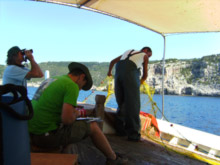
This information will be evaluated in order to determine the main factors affecting seabird bycatch and to propose, in collaboration with fishermen, alternative fishing gear and practices that reduce the risk of seabird bycatch. For this purpose, a series of meetings with fishermen and an information dissemination campaign will be carried out.
Results:
The collection of data for the assessment of seabird bycatch is being implemented by the TEI of Ionian islands in the Ionian Sea and by the HCMR in collaboration with HOS and MOm in the Aegean Sea.
Until the summer of 2010, 127 fishing trips with on-board observers have been carried out in all major fishing areas of the Aegean and Ionian Sea.
Additional information is being collected through questionnaires for fishermen (pdf )
)
Preliminary results of seabird bycatch assessment in the Ionian Sea, presented at the 3rd International Eurasian Ornithology Congress –Mytilini-Greece, April 2010.- Many of the project’s actions are focused on public awareness for the general public and specific target groups. These actions disseminate information on matters such as the project species, the threats they face, the conservation actions implemented in the project’s framework and the importance of the marine protected areas network, in particular that of the marine IBA, regarding the conservation not only of the project target species but of all marine biodiversity.
Actions also include working groups, presentations and events for the general public, design and publication of environmental education and awareness material (leaflets, posters, etc), special editions, a mobile exhibition in the Aegean islands, permanent exhibitions at Information Centres and kiosks, as well as dissemination of the project’s aims and actions through local and national media.
Workshops, participation at conferences, scientific publications
Planning Workshop for the Identification of Marine IBAs and Seabird Monitoring, 6th-8th March 2009, Athens
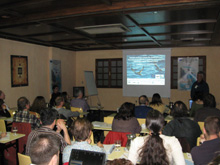
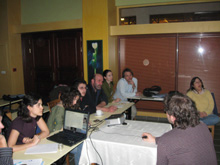
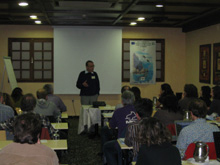
The 1st project workshop was organized in Vravrona (near Athens) on the 6th-8th March 2009, and was focused on the improvement of information exchange between the project team and other national and international experts on seabird conservation. Although the main objectives of the workshop were to improve networking and exchange of knowledge and expertise between organisations and individuals involved in the protection of seabirds and the designation of Marine IBAs, it also intended to use the expertise of the workshop participants to finalize the methods involved in the designation of Marine IBAs in the framework of the present project. A total of 44 participants, both from Greece and abroad, took part in the workshop. The workshop’s agenda was divided in four main subjects: (1) general survey methods, (2) species specific methods, (3) conclusions and (4) fieldwork plan for 2009 regarding Marine IBAs. Participants from Greece included project staff and national seabird conservation experts. Participants from abroad included experts in the field of seabird surveys, Marine IBAs and seabird conservation, as well as the representatives of other Birdlife partners that are planning the implementation of similar projects in their countries (i.e. Slovenia, Bulgaria). The results and conclusions of the workshop provided the baseline guidelines, information and methodologies for the implementation of the project actions. Contacts with workshop participants continued after the workshop in order to finalize seabird methodologies and to exchange technical information regarding the implementation of project actions.
Workshop programme pdf
List of participants pdf
Workshop for the study and conservation of seabirds, February 2010, Istanbul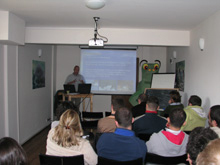
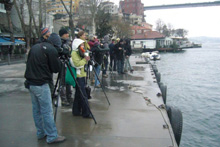
HOS not only carries out research and conservation actions in Greece, but also promotes the implementation of similar projects in other countries. In particular, it promotes networking and cooperation with those foreign ornithological organizations and research institutions from neighbouring countries also aiming at the conservation of seabirds. In this context, a meeting was held in Istanbul, organized by Doğa Derneği (BirdLife partner in Turkey) and attended by HOS and BSPB (BirdLife partner in Bulgaria). The main objective of this meeting was the exchange of knowledge and rendering of know-how from HOS’ part. This meeting also marked the beginning of coordinated and common actions among the three organizations for the study and conservation of seabirds.
HOS carried out a basic training on the main seabird survey methods, including two practical sessions at the Bosphorus, both from sea and from land.Seabird LIFE Project Closing Workshop, 3rd-4th December 2012, AthensProject’s closing workshop took place in Athens, on the 3-4th December 2012 and was attended by 46 participants including representatives of the project partners, Greek NGOs, BirdLife partners, seabird experts from Greece and abroad, Management Bodies of the Marine National Park of Alonnisos Northern Sporades and Karpathos – Saria. Additionally, the workshop was attended by representatives of the Ministry of Environment, Energy & Climate Change and the Ministry of Rural Development and Food, which are competent for the issues on Protected Areas/ Natura 2000 Network and fisheries in Greece, respectively. Participation of representatives of the Ministries and the Management Bodies is considered to be of vital importance for optimal utilization of project outputs e.g. marine IBAs inventory, results of bycatch assessment, conservation measures such as rat eradications and gull control by the competent authorities.
Closing workshop presentations
Scientific publications
10th International Conference of Seabird Group held in Bruges, Belgium. 27-30 Μarch 2009
Preliminary results of monitoring the breeding performance of the Cory’s Shearwater on Strofades Island Complex (Ionian Sea, Western Greece). Karris G., Xirouchakis S., Grivas K., Dimalexis T., Fraguedakis-Tsolis S., Sinos G. & Sfendourakis S. pdf

11thInternational Congress on the Zoogeography, Ecology and Evolution of Eastern Mediterranean -11th ICZEGAR-), 21-25 October 2009, Irakleio, Crete
Elements of Breeding Biology and estimation of reproduction success in a N. Aegean colony of the seabird Phalacrocorax aristotelis desmarestii. Thanou E., Christidis A., Giokas S., Sfenthourakis S. & Fraguedakis-Tsolis S. pdf

3 rdInternational Eurasian Ornithology Congress –IEOC-), 8-10 Απριλίου 2010, Mytilini
First data on seabird by-catch from the Greek gillnet and long-line fishery (Ionian Sea, western Greece). G.Karris, K. Poirazidis, D. Tziertzidis, D. Vourgaris, J. Fric, D. Portolou & S. Sfendourakis pdf

Brief Report on European Seabirds at Sea (ESAS) recordings in Greece. K. Gaganis, J.Fric, T. Dimalexis, P. Dendrinos, M. Panayiotopoulou, S. Zakkak pdf
Comparison of modeling approaches for estimating abundance patterns of seabirds in the N. Aegean Sea using ESAS data. S. Zakkak, M. Panagiotopoulou & J.M. Halley pdf
Project’s poster presentations at the 3rd International Eurasian Ornithology Congress in Mytilini © HOS
5thPanhellenic Congress of Ecology «Ecological processes in space and time », 7-10 October 2010, Patra
Audouin’s Gull population in Greece 10 years after. D. Portolou, V. Saravia Mullin, J. Fric, Α. Evangelidis & Τ. Dimalexis pdf

A failed breeding period for the Mediterranean Shag in Northern Aegean.Ε. Thanou, Α. Christidis, J. Fric, S. Giokas, S. Sgendourakis & S. Fraguedakis – Τsolis pdf
Application of ESAS methodology for the estimation of distribution, abundance and behavioural patterns of seabirds in the North Aegean Sea. Sylvia Zakkak, Master Thesis pdf

8th Conference of the European Ornithologists’ Union, 27-30 August 2011, Riga, Latvia
Does by-catch pose a threat to seabirds in the Ionian Sea (Eastern Mediterranean)? A quantitative research of local fisheries – J. Kalfopoulou, Z. Kitsou, G. Karris, K. Poirazidis & J. Fric pdf

3th MEDMARAVES Pan-Mediterranean Symposium, October 2011, Alghero, Sardinia
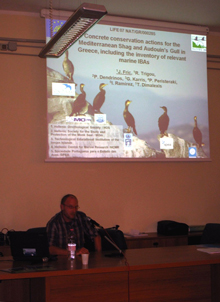
The breeding population of Audouin’s Gull Larus audouinii in Greece – V. Saravia, D. Portolou, A. Evangelidis, K. Gaganis, A. Manolopoulos & J. Fric pdf
Conservation actions for the Mediterraneran Shag Phalacrocorax aristotelis and Audouin’s Gull Larus audouinii in Greece, including inventory of relevant marine IBAs - Jakob Fric, Roula Trigou, Panagiotis Dendrinos, Georgios Karris, Panagiota Peristeraki and Tasos Dimalexis presentation
10th Panhellenic Symposium of Oceanography and Fisheries, May 2012, Athens
Evaluation of seabird by-catch mortality as a conservation threat in the Southern Ionian Sea (Eastern Mediterranean) - Karris G., Fric J., Kitsou Z., Kalfopoulou J. & Poirazidis K pdf

“International Workshop on Island Natural Restoration”, May 2012, Corvo island, Azores
- Island natural habitat restoration on Greek islands – J. Fric
12thInternational Congress on the Zoogeography, Ecology and Evolution of Eastern Mediterranean -11th ICZEGAR-), 18-22 June 2012, Athens
- Foraging distribution and behaviour of the Audouin’s Gull (Larus audouinii) in the Aegean Sea – J. Fric, V. S. Mullin, A. Evangelidis, K. Gaganis, D. Portolou, T. Kastritis pdf

-Identification of Marine Important Bird Areas (Marine IBAs) for the Mediterranean Shag (Phalacrocorax aristotelis desmarestii) and Audouin’s Gull (Larus audouinii) in Greece - . J. Fric, A. Manolopoulos, P. Dendrinos, P. Kasapidis, P. Peristeraki, G. Karris, 1T. Kastritis pdf
6th Panhellenic Congress of Ecology "Ecological Research in Greece: Trends, Challenges and Applications". 4-7 October 2012, Athens
-Genetic structure and patterns of differentiation of black rat (Rattus rattus) in island-islet complexes of Greek Seas. Tsaparis D., Fric J., Kristoffersen J.B., Karris G. & Kassapidis P. (in greek) pdf

-Qualitative and quantitative evaluation of the awareness level of the visitors of the information kiosk in Zakynthos, in the framework of the LIFE07 NAT/GR/000285 project, Ziarka D., Martinis Α., Karris G., Kambasi Α., Trigou V. 2012. (in greek) pdf

-Evaluation of the abundance and distribution of three seabird species in the Northern Aegean Sea: what is the importance of the area for their conservation? Zakkak S., Panagiotopoulou Μ., & Halley J.M. (in greek) pdf

19th Benelux Congress of Zoology, Integrative biology “From ecology to molecules”. Université Libre de Bruxelles. Bruselles, 19-20 October 2012-Spatiotemporal distribution and behaviour of three common seabird species in Laganasgulf and Argassi (SE Zakynthos, Ionian Sea, Western Greece). Drechsel F., Karris G., Kokkali A., Voulgaris M.D. & Poulicek M pdf

Communication and dissemination
Project’s mobile exhibition
MOm, in collaboration with HOS, has created a mobile information exhibition specially designed to be on show at the project’s areas ports during the fieldwork trips. During the summer, the project’s research team sails in the “Odysseia”, MOm’s vessel, around the islands of the north Aegean. The mobile exhibition includes 6 panel exhibits: “The Audouin’s Gull”, “The Mediterranean Shag”, “The valuable small uninhabited islets”, “Actions in the Greek islands”, “Seabirds of the Greek Seas”.
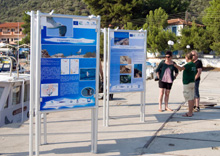
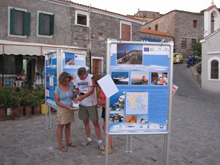

Porto Koufo, Chalkidiki Molyvos, Lesvos Myrina, Lemnos 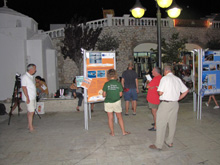
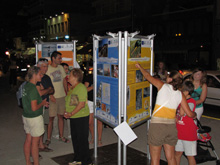
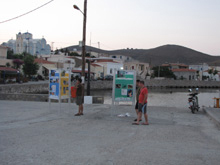
Skyros Mytilini Psara port 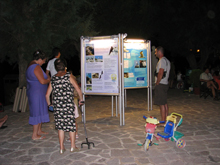
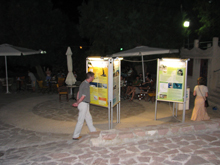
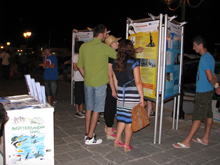
Eressos, Lesvos Sigri, Lesvos Myrina, Lemnos – July 2011 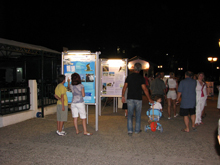
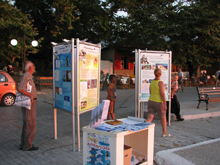
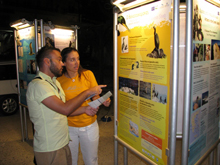
Skiathos – July 2011 Limenas, Thasos Limenaria, Thasos
Special exhibition in Alonnisos Information Centre
In addition to the projects mobile exhibition, a second exhibition was set and operated in MOm’s Information Centre in Patitiri, the main port of the National Marine Park of Alonnisos Northern Sporades. In the Information Centre’s facilities, a special thematic corner was devoted to the project and the two target species. The exhibition included three exhibit panels containing texts and photographs that present key information on the biology and ecology of the two target species and the seabirds of the Aegean Sea, the importance of the uninhabited islets of the Aegean and basic information on project’s rational, activities and expected results. Furthermore, information material such as leaflets and posters, was also available for the visitors.
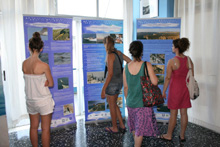
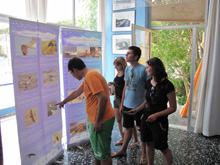
A special thematic corner devoted to the project in MOm’s Information Centre in Alonnisos © MOm Operation of an info kiosk in the central square of the town of Zakynthos
Under the framework of the public awareness campaign in Zakynthos and the Ionian Sea, every year, from May until October, an information kiosk is operated by the TEI of Ionian Islands in the central square of the town of Zakynthos (Democracy square). The kiosk is operated in a daily basis by the students of the department of Environmental Technology and Ecology of TEI, working on volunteer basis. Project information material is available in the kiosk, as well as additional info. More than 18.000 people visited the info kiosk from June 2010 until October 2011 and were informed for the LIFE Project and seabird conservation.
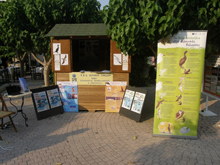
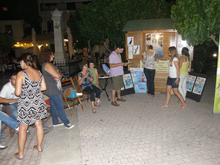
Project information kiosk in Zakynthos. Awareness on board!
Since the summer of 2011, the Attica Group is supporting project public awareness actions by making available information material upon seabirds, the LIFE project and the importance of island and marine environment to the passengers travelling on all vessels of Blue Star Ferries and Superfast Ferries to the Cyclades, Dodecanese and Crete.
The passengers of the Attica Group’s vessels sailing together with seabirds in the Aegean archipelago, have the opportunity to observe pelagic seabirds at open sea (Cory’s Shearwaters, Yelkouan Shearwaters and if lucky European Storm Petrels) and coastal seabirds when approaching land (Audouin’s Gulls, Mediterranean Shags and Yellow-legged Gulls). A leaflet available at the reception desk will help passengers recognise seabirds and at the same time allow them to contribute to the census of seabird population in Greece, by filling in a special observation form, attached to the leaflet and handing it in at the reception desk or posting the observations at the seabird project’s website.
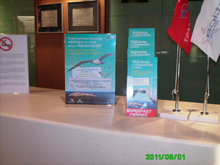
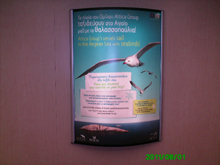
Project leaflets and promo poster available in the reception of the Blue Star Ferries vessels sailing to Cyclades Backlit banner in one of the Blue Star Ferries vessels sailing to Cyclades Distribution of project information material at selected sites in island and coastal areas of Greece
Project information material is distributed to more than 45 sites in island and coastal areas all over Greece (public authorities, educational institutions, travel agencies, private companies)
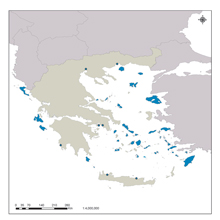
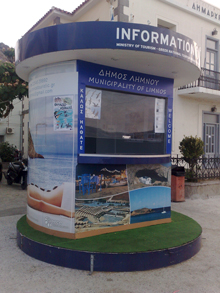
Map of the sites with available project information material 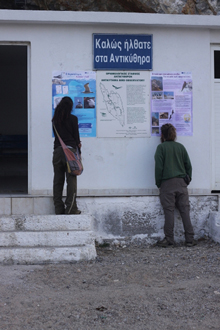

Project banners at the port of Antikythira Project banners in city hall of Fournoi Special events/ Presentations
Presentation in Skyros – August 2009
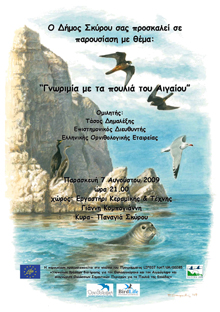
Poster invitation for the Presentation in Skyros Special Event in Floisvos-Athens for the Celebration of the World Environment Day– June
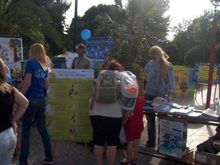
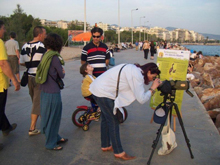
Information stand in Floisvos, Athens – June 2011 Seabird-watching in Floisvos, Athens – June 2011 Participation in the Folktale Festival in the island of Kea – July 2011

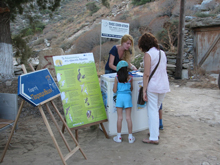
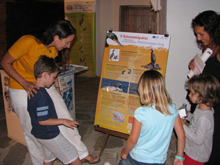
Public awareness in the Folktale Festival in the island of Kea - July 2011 Participation in the British Birdwatching Fair (August 2010, 2011)
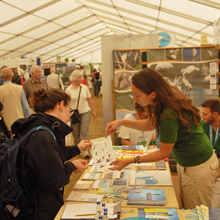
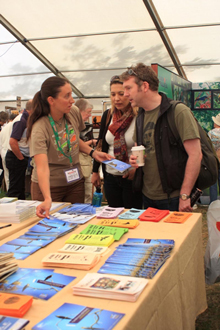
Visitor information during the British Bird Fair Screening of the project video to the “Open Cinema” event in Samothraki Island – August 2011
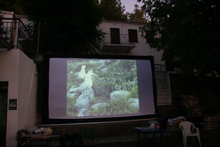
Screening of the project video to the “Open Cinema” event in Samothraki Island – August 2011 Information kiosk in Messologi - Central Greece in collaboration with the local Sailing Club, August 2011
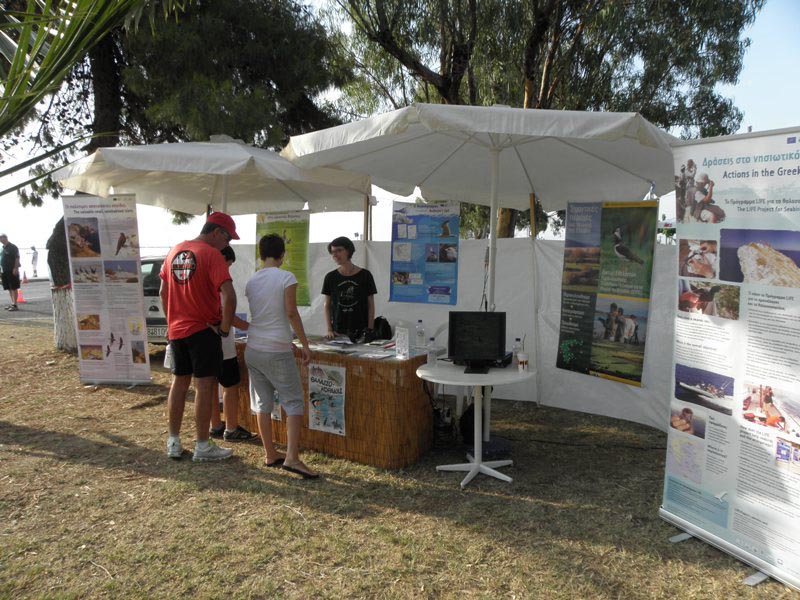
Information kiosk in Messologi - Central Greece, August 2011 Participation at Ecofestival, Athens - November 2011
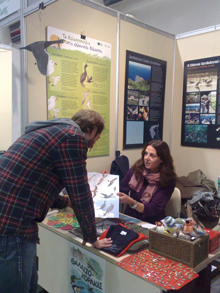
Visitor information during the Ecofestival - Athens, November 2011 © R. Trigou/ HOS Media publications
Plenty of publications have been published in local, national and international media during the length of the project, aiming to inform the public on the project species, the conservation actions implemented in the project’s framework, as well as other issues related to seabird conservation, such as the algal boom in the north Aegean, etc. In addition, there is continuous reference to the project and the development of its actions in all of HOS’ regular publications (Oionos magazine, e-onos newsletter, HOS Conservation Review, etc).
Example of publications:
National Press “TO VIMA”/ Algal Bloom responsible for the disappearing Mediterranean Shag
National Press “TO VIMA”/ Sailing with Seabirds
National Magazine “ΟΙΚΟ” of KATHIMERINI National Press/ Animals in Danger: The Audouin’s Gull
HERALD TRIBUNE/ Drive Highlight Threat to seabirds pdf

National Press “ETHNOS”/ Seabirds in danger pdf

National Press “ETHNOS”/ SOS for Audouin’s Gull pdf

National Press “NEA”/ Audouin’s Gull: the flag species of the Aegean Sea pdf

National Press “Eleftheros Typos”/ The suspended step of Audouin’s Gull pdf

Local Press “Rodiak”/ Alliance for the seabirds of the Aegean Sea pdf

Thasos Local Press «Thasiaki»/ The island of Thasos protects its seabirds pdf

Thasos Local Press «Thasion Gi»/ The island of Thasos protects its seabirds pdf

Real News/ Death traps for seabirds pdf

https://www.kavalanet.gr/enimerosi/news_static/1256237767.php
https://www.thassos-nature.gr/?q=node/82
https://walking-greece.ana-mpa.gr/articleview2.php?id=10754
https://www.evdomi.gr/pub/starcms/repository/static/articles/ar_45013_1.asp
"NOVA BEST" magazine- Issue Νο 6 - 2010/ Seabirds of the greek seas pdf

Environmental education
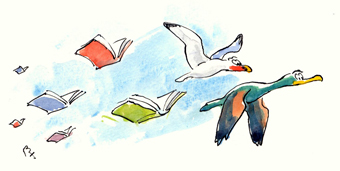
The Environmental Education kit “Audouin’s Gull and the Mediterranean Shag take us on a journey to the Greek archipelagos” is addressed to teachers and students who wish to get familiar with the Audouin’s Gull and the Mediterranean Shag and the rest of the seabirds of the Greek seas. Together with the seabirds, students and teachers will travel in the archipelagos in order to meet the unique nature of the Aegean and Ionian Sea.
This kit is mainly addressed to children from the last grades of primary school, as well as high school, but includes activities for older kids as well. The kit consists of env. education avtivities, an information booklet for educators (and anyone else who shows interest!), a Power Point presentation as well as an informative leaflet and posters of the project’s target species. The environmental education material will be further enriched with a short 20 minute documentary on seabirds and the LIFE Project.
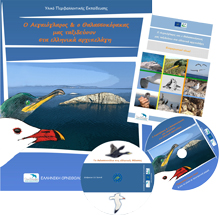
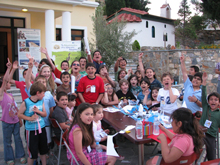
The kit follows the same line of a previous environmental education kit created for the LIFE project for the conservation of Eleonora’s Falcon in Greece, which already addressed the issues of seabird and island ecosystems conservation, and in general the protection of the outstanding ecosystem of the Aegean Sea.

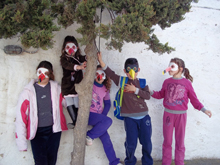
Environmental Education activities included in the kit:
· A seabird but which seabird?
Seabird identification key- Make your own seabird colony
Drawing for the familiarization of the seabird identification characteristics.· Become a seabird!
Creation of seabird masks· The Audouin’s Gull and the Mediterranean Shag fly over Important Seabird Areas
Drawing of Marine Important Bird Areas· Lunch for seabirds!
Audouin’s Gull and Mediterranean Shag mobile making and food habits investigation.· Names, names, names!!!
Seabird name game· The seabird flock
Chearful activity mimicking seabird calls· The Cory’s Shearwater floor game
Floor game to get to know the life of pelagic seabirds· Seabird by-catch – seabird spinning
Seabird by-catch problem and solution card game· Misspelling seabirds
Cheerful seabird name game puns· Round and round the bait
Seabird by-catch children’s game· The smudger
Endangered Greek sea animal card game· Seabirds: so similar yet different
Memory game for the special characteristics of seabirds· “Kalikatzou”, “Varvaki”, “Kepfos” and other seabird local names
Local birdlife folklore elements· Seabird by-catch research
Questionnaire based research on seabird by-catch on fishing gear· Time for some reading!
Reading and commentary on writing dedicated to gulls· Marine Important Bird Areas! Yes, but in action….?
Depiction of problems on a map – alternative solution investigation· Mediterranean Shags and fishermen in despair!
Talk on the overall understanding of an issue· Scaling Wind Farms
Debate for Wind Farms (pros and cons)· Islets without peace
Matching of human activities with potential consequences on sensitive speciesThe Environmental Education material is only available in greek.
For more information please contact HOS (+30 2108227937, +302108228704, Mrs Ioanna Kontozisi – Env. Education Officer, This email address is being protected from spambots. You need JavaScript enabled to view it.
Project posters:
Projects posters for the Audouin’s Gull
 and the Mediterranean Shag
and the Mediterranean Shag
Special media publications:
- Magazine “Aerostato” of the Ministry of Culture of Greece/ Seabirds: the stars of the summer

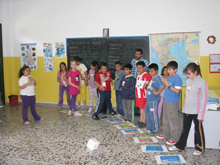
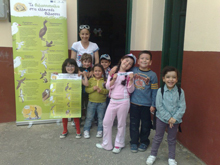
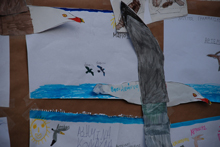
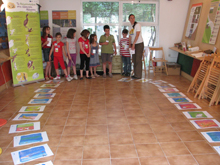
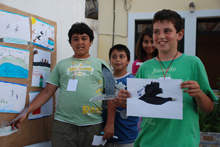
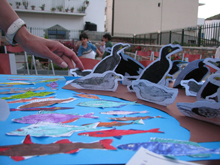
Summer environmental education workshops
In Zakynthos...
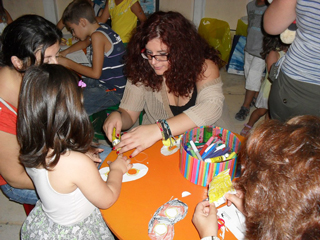
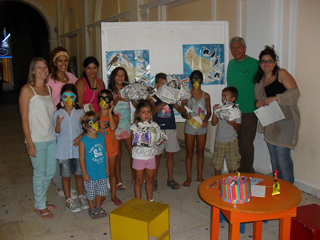
Summer environmental education workshop in Zakynthos – August 2012 In Syros…
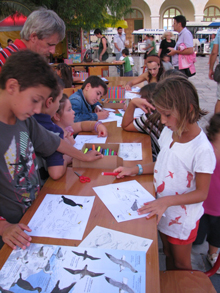
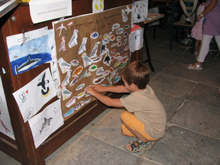
Summer environmental education workshop in Syros – August 2011 In Milos…
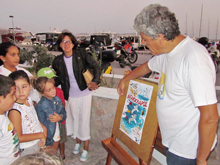

Summer environmental education workshop in Milos – August 2011 In Lemnos…
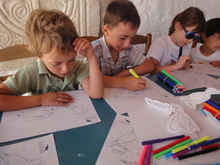
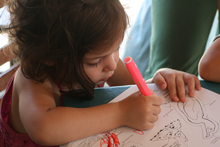
Summer environmental education workshop in Lemnos – August 2011 Project publications
- Important Areas for Seabirds in Greece (Marine IBA Book)
- European Seabirds at Sea Methodology (in greek)
- After LIFE Conservation Plan
- Special editions of the HOS magazine (OIONOS), dedicated to the Seabird LIFE project (in greek):
Issue 40 Issue 44 Issue 48 Issue 50 - Project leaflet "Seabirds of the Greek Seas"
In Greek
 , English
, English  , German
, German , Italian
, Italian 
- Leaflet “Sailing with seabirds in the Aegean Sea”

- Leaflet “A visitor’s guide to approaching uninhabited islets" (in greek)

- Project banners
- “The Audouin’s Gull”
- “The Mediterranean Shag”
- “The invaluable small, uninhabited islets”
- “Actions in the Greek islands”
- “Seabirds of the Greek seas”
- “Pelagic seabirds of the Aegean seas”- Project posters
- Audouin’s Gull
- Mediterranean Shag
- “A visitor’s guide to approaching uninhabited islets" (in greek)- Quick identification guide to seabirds (ENG
 ,GR
,GR )
)Other publications with reference to the project
- HOS Conservation Review 2009
- HOS magazine "Oionos":
- Issue 37 (March-May 2009). Getting to know the seabirds of the LIFE Project.(in greek)
– Issue 37 (March-May 2009). LIFE Project news. (in greek)
– Issue 38 (June-August 2009). LIFE Project news. (in greek)
– Issue 40 (December-February 2009-2010). LIFE Project news. (in greek)
– Issue 41 (March-May 2009). LIFE Project news. (in greek)
– Issue 41 (March-May 2009). LIFE Project news: New Audouin’s Gull census in Greece. (in greek)
– Issue 45 (March-May 2011). LIFE Project news (in greek)
– Issue 45 (March-May 2011). Sailing with seabirds in the Aegean Sea (in greek)
– Issue 46 (June-August 2011). Fly with us to Syros kai Milos along with seabirds (in greek)
– Issue 46 (June-August 2011). Audouin’s Gull recovery 12 years after! (in greek)
– Issue 48 (January-February 2012). New oionos special edition! (in greek)
- Newsletter:
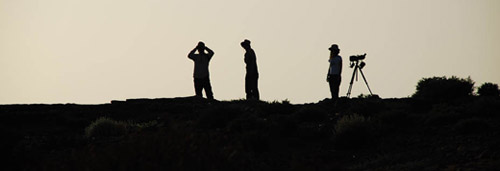
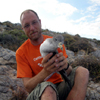
Jakob Fric
Συντονιστής Προγράμματος
Project manager

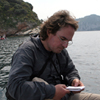
Τάσος Δημαλέξης
Συντονιστής Προγράμματος έως τον Ιούνιο 2010Tasos Dimalexis
Project manager until June 2010
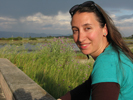
Ρούλα Τρίγκου
Συντονίστρια ΕπικοινωνίαςRoula Trigou
Communications Coordinator
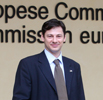
Ξενοφώντας Κάππας
Διαχειριστής Προγράμματος
Xenophon Kappas
Project administrator

Θάνος Καστρίτης
Υπεύθυνος Δράσεων Θαλάσσιων IBA
Thanos Kastritis
Marine IBA Coordinator
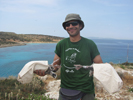
Κώστας Γαγάνης
Υπεύθυνος Δράσεων για εισαχθέντα είδη, Υπεύθυνος ESAS
Kostas Gaganis
Invasive species Coordinator, ESAS Coordinator
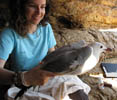
Victoria Saravia
Υπεύθυνη Δράσεων Παρακολούθησης
Monitoring Coordinator


Άγγελος Ευαγγελίδης
Ερευνητής πεδίου/ Βοηθός Δράσεων για εισαχθέντα είδη
Angelos Evangelidis
Field researcher/ Invasive species Assistant
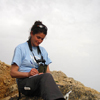
Δανάη Πορτόλου
Υπεύθυνη Διαχείρισης ΔεδομένωνDanae Portolou
Database Manager

Άρης Μανωλόπουλος
Υπεύθυνος Γεωγραφικών Εφαρμογών
Aris Manolopoulos
GIS Manager

Ιωάννα Κοντοζήση
Υπεύθυνη Περιβαλλοντικής Εκπαίδευσης
Ioanna Kontozisi
Environmental Education Officer

Εύα Στεφανάκη
Οικονομικός Διαχειριστής
Eva Stefanaki
Project Accountant

Μαργαρίτα Τζάλη
Ερευνήτρια πεδίου
Margarita Tzali
Field researcher
Εξωτερικοί συνεργάτες/ External assistance 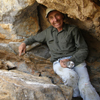
Dr. Dietrich Ristow
Ειδικός σε θέματα θαλασσοπουλιώνSeabirds expert
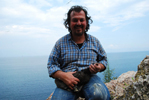
Άρης Χρηστίδης
Ερευνητής πεδίουAris Christidis
Field researcher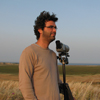
Λευτέρης Κακαλής
Ερευνητής πεδίου (Βόρειο Αιγαίο)Lefteris Kakalis
Field researcher (Northern Aegean)
Σταύρος Ξηρουχάκης
Ερευνητής πεδίου/ Μουσείο Φυσικής Ιστορίας ΚρήτηςStavros Xirouchakis
Field researcher/ Natural History Museum of Crete
Παναγιώτης Λατσούδης
Ερευνητής πεδίου
Panagiotis Latsoudis
Field researcher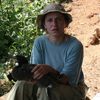
Μαρία Παναγιωτοπούλου
Ερευνήτρια πεδίουMaria Panagiotopoulou
Field researcher
Σύλβια Ζακκάκ
Ερευνήτρια πεδίουSylvia Zakkak
Field researcher
Carlota Viada Sauleva
Ερευνήτρια πεδίου
Field researcher
Κώστας Παπακωνσταντίνου
Χειριστής σκαφώνKostas Papakonstantinou
Boat captain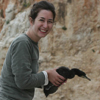
Εύη Θάνου
Ερευνήτρια πεδίου/ Πανεπιστήμιο ΠατρώνEvi Thanou
Field researcher/ University of Patras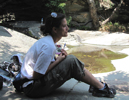
Χριστίνα Κασσάρα
Ερευνήτρια πεδίου/ Πανεπιστήμιο Πατρών
Christina Kassara
Field researcher/ University of PatrasΧριστίνα Ζωγράφου
Ερευνήτρια πεδίου (Βόρειο Αιγαίο)Christina Zografou
Field researcher (Northern Aegean)
Πολύβιος Δεληγιάννης
Ερευνητής πεδίου
Poluvios Deligiannis
Field researcher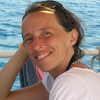
Καλλιόπη Στάρα
Ειδικός σε θέματα Π.Ε.Kaliopi Stara
Environmental Education expert
Βασίλης Χατζηρβασάνης
Ειδικός σε θέματα Π.Ε./ ΕικονογράφοςVassilis Hatzirvassanis
Environmental Education expert/ Designer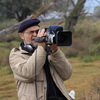
Άγγελος Παπαστεφάνου
Σκηνοθέτης
Angelos Papastefanou
Director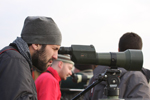
Δημήτρης Βαβύλης
Ερευνητής πεδίου
Dimitris Vavilis
Field Researcher

Τάσος Μπούνας
Ερευνητής πεδίου
Tasos Bounas
Field Researcher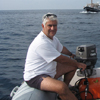
Πάνος Δενδρινός
Συντονιστής Προγράμματος MOmPanos Dendrinos
MOm Coordinator
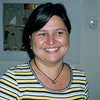
Στέλλα Αδαμαντοπούλου
Συντονίστρια Δράσεων Διατήρησης MOmStella Adamantopoulou
MOm Coordinator of in situ conservation activities
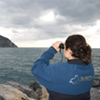
Μαριάννα Ψαραδέλλη
Ερευνήτρια πεδίου
Mariana Psaradeli
Field researcher

Αλέξανδρος Καραμανλίδης
Ερευνητής πεδίουAlexandros Karamanlidis
Field researcher

Κώστας Πανέρης
Τεχνικός ΠεδίουKostas Paneris
Field Technician
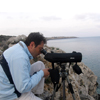
Γιώργος Καρρής
Συντονιστής Προγράμματος ΤΕΙ
George Karris
TEI Coordinator
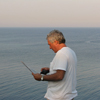
Αριστοτέλης Μαρτίνης
Συντονιστής Επικοινωνίας ΤΕΙAristotelis Martinis
TEI Communication Coordinator
Κατερίνα Καμπάση
Ερευνήτρια ΤΕΙKaterina Kampasi
TEI Researcher

Κώστας Ποϊραζίδης
Ερευνητής ΤΕΙKostas Poirazidis
TEI Researcher
Έφη Σκώττη
Ερευνήτρια ΤΕΙEfi Skotti
TEI Researcher
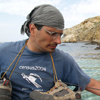
Κώστας Γρίβας
Ερευνητής πεδίου (δράσεις Bycatch)
Kostas Grivas
Bycatch Researcher
Νότα Περιστεράκη
Συντονίστρια Προγράμματος ΕΛΚΕΘΕ (ΙΘΑΒΙΠ)Nota Peristeraki
HCMR (IMBR) Coordinator
Παναγιώτης Κασαπίδης
Συντονιστής Προγράμματος ΕΛΚΕΘΕ (ΙΘΑΒΙΓ)
Panagiotis Kasapidis
HCMR (IMBG) Coordinator
Βασίλης Βαλαβάνης
Ειδικός Συστημάτων Γεωγραφικών Πληροφοριών
Vassilis Valavanis
GIS expert
Γιώργος Τσερπές
Ειδικός αλιευτικής διαχείρισηςGeorge Tserpes
Fish population dynamics expert
Γιώργος Λαζαράκης,
Ιχθυολόγος/ ερευνητής πεδίου
George Lazarakis
Ichthyologist/ field researcher
Νεκτάριος Κυπραίος
|Ιχθυολόγος/ ερευνητής πεδίουNektarios Kypraios
Ichthyologist/ field researcher

Ivan Ramirez
Συντονιστής SPEA
SPEA Coordinator

